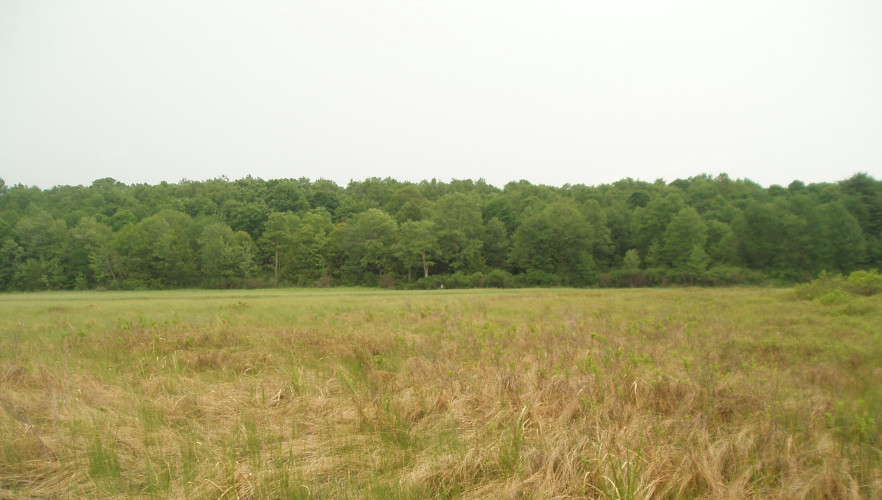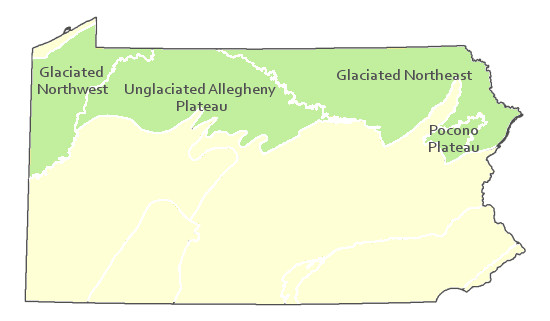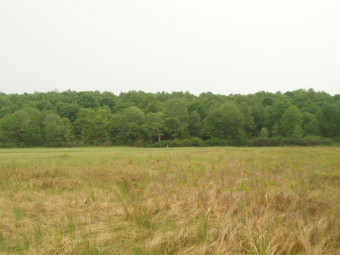Many-Fruited Sedge – Bladderwort Poor Fen
System: Palustrine
Subsystem: Herbaceous
PA Ecological Group(s): Peatland Wetland
Global Rank:GNR
![]() rank interpretation
rank interpretation
State Rank: S2

General Description
These are peatlands or “poor fens” influenced to some degree by groundwater and surface water enrichment (pH 5-5.5). They are dominated by sedges, of which many-fruited sedge (Carex lasiocarpa) is the most characteristic. Flat-leaved bladderwort (Utricularia intermedia) is also characteristic. Other species commonly found in these systems include the sedge Carex lacustris, leatherleaf (Chamaedaphne calyculata), marsh cinquefoil (Potentilla palustris), bogbean (Menyanthes trifoliata), marsh St. John’s-wort (Triadenum virginicum), tussock sedge (Carex stricta), meadow-sweet (Spiraea latifolia), common cat-tail (Typha latifolia), bluejoint (Calamagrostis canadensis), marsh fern (Thelypteris palustris), and cranberry (Vaccinium macrocarpon).
Rank Justification
Imperiled in the state because of rarity due to very restricted range, very few populations (often 20 or fewer), steep declines, or other factors making it very vulnerable to extirpation.
Identification
- Dominated by many-fruited sedge (Carex lasiocarpa)
- Has a floating mat comprised of the roots of sedges
- Typically there is open water adjacent to the fen
Herbs
* limited to sites with higher soil calcium
Vascular plant nomenclature follows Rhoads and Block (2007). Bryophyte nomenclature follows Crum and Anderson (1981).
International Vegetation Classification Associations:
USNVC Crosswalk:None
Representative Community Types:
Wiregrass Sedge Shore Fen (CEGL005229)
NatureServe Ecological Systems:
Laurentian-Acadian Alkaline Fen (CES201.585)
NatureServe Group Level:
None
Origin of Concept
Fike, J. 1999. Terrestrial and palustrine plant communities of Pennsylvania. Pennsylvania Natural Diversity Inventory. Pennsylvania Department of Conservation and Recreation, Bureau of Forestry, Harrisburg, PA. 86 pp.
Pennsylvania Community Code*
HU : Many Fruited Sedge – Bladderwort Peatland
*(DCNR 1999, Stone 2006)
Similar Ecological Communities
Many-Fruited Sedge – Bladderwort Poor Fen differs from the Sphagnum – Beak-rush Peatland in that this community is characterized by a lack of leatherleaf (Chamaedaphne calyculata) and many-fruited sedge (Carex lasiocarpa) and the Sphagnum – Beak-rush Peatland lacks the groundwater enrichment that characterizes this type. This type lacks the heavy sphagnum layer that characterizes the Sphagnum – Beak-rush Peatland.
Fike Crosswalk
Many fruited sedge - bladderwort peatland
Conservation Value
Several rare plants are known to occur in this community type including many-fruited sedge (Carex lasiocarpa) and flat-leaved bladderwort (Utricularia intermedia). This community serves as foraging habitat for waterfowl, swallows, rails, and bats, as well as habitat for many species of dragonflies and damselflies.
Threats
Beaver are likely the greatest threat to this type and ironically may be the cause of some of the occurrences as well. Exotic invasive plants such as common reed (Phragmites australis ssp. australis) and purple loosestrife (Lythrum salicaria) may become established as well as aggressive native species like common cat-tail (Typha latifolia).
Management
Where disturbances are unavoidable, the wetland should be monitored for changes in vegetation, especially invasive species.
Research Needs
Additional research is needed to document the environmental drivers for the origin and persistence of the community type.
Trends
There are insufficient data to assess whether this community is increasing or decreasing in abundance. Beaver activity and resulting hydrologic alterations to some wetlands may favor the formation of the community type, but trend data are lacking.
Range Map

Pennsylvania Range
Glaciated Northeast, Glaciated Northwest, Pocono Plateau, Unglaciated Allegheny Plateau.
Global Distribution
Connecticut, Massachusetts, New Hampshire, New Jersey, New York, Pennsylvania, Rhode Island, and Vermont. This community also extends into Quebec.
Cowardin, L.M., V. Carter, F.C. Golet, and E.T. La Roe. 1979. Classification of wetlands and deepwater habitats of the United States. U.S. Fish and Wildlife Service. Washington, D.C. 131 pp.
Edinger, Gregory J., D.J. Evans, Shane Gebauer, Timothy G. Howard, David M. Hunt, and Adele M. Olivero. 2002. Ecological Communities of New York State. Second Edition. A revised and expanded edition of Carol Reschke's Ecological Communities of New York State. New York Natural Heritage Program, New York State Department of Environmental Conservation. Albany, NY. 136 pp.
Fike, J. 1999. Terrestrial and palustrine plant communities of Pennsylvania. Pennsylvania Natural Diversity Inventory. Harrisburg, PA. 79 pp.
Johnson, C.W. 1985. Bogs of the Northeast. University Press of New England.
Larsen, J.A. 1982. Ecology of Northern Lowland Bogs and Conifer Forests. Academic Press, New York.
NatureServe. 2009. NatureServe Central Databases. Arlington, Virginia. USA
Pennsylvania Department of Conservation and Natural Resources (DCNR). 1999. Inventory Manual of Procedure. For the Fourth State Forest Management Plan. Pennsylvania Bureau of Forestry, Division of Forest Advisory Service. Harrisburg, PA. 51 ppg.
Rhoads, A.F. and T.A. Block. 2007. The Plants of Pennsylvania, 2nd ed. University of Pennsylvania Press.
Stone, B., D. Gustafson, and B. Jones. 2006 (revised). Manual of Procedure for State Game Land Cover Typing. Commonwealth of Pennsylvania Game Commission, Bureau of Wildlife Habitat Management, Forest Inventory and Analysis Section, Forestry Division. Harrisburg, PA. 79 ppg.
Thompson, E. 1996. Natural communities of Vermont uplands and wetland. Nongame and Natural Heritage Program, Department of Fish and Wildlife in cooperation with The Nature Conservancy, Vermont chapter.
Wenger, S. 1999. A Review of the Scientific Literature on Riparian Buffer Width, Extent and Vegetation. Office of Public Outreach, Institute of Ecology, Univ. of Georgia, Athens.
Cite as:
Davis T. 2022. Pennsylvania Natural Heritage Program. Many-Fruited Sedge – Bladderwort Poor Fen Factsheet. Available from: https://www.naturalheritage.state.pa.us/Community.aspx?=16008 Date Accessed: October 16, 2025







